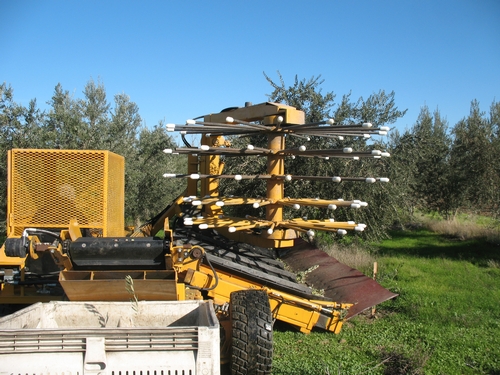Keeping olives on the table
Table olives have always been a staple on my family’s fall relish tray so I took notice when I heard this discouraging news: Labor costs are killing the table olive industry. Table olive growers spend more than half of their gross returns on the cost of manually harvesting their crop.
“That’s a ridiculous equation,” says Dennis Burreson of Orland, grower and chairman of the research committee of the California Olive Committee. “We can’t survive if we’re spending more than half our gross returns on labor.”
But here’s the heartening news: With the help of UC Cooperative Extension specialist Louise Ferguson (right) and a large group of collaborators, the industry is doing something about it. They are developing the means to mechanize the devilishly difficult task of picking table olives.
“I think mechanical harvesting will soon revolutionize the table olive industry,” said Ferguson, pomologist with the UC Davis Department of Plant Sciences and director of the UC Davis Fruit & Nut Research and Information Center.
Mechanical harvesters are commonplace for countless commodities, including olive oil olives. What is it about table olives that make them so hard to mechanically pick?
They bruise easily, for one thing, and bruised olives don’t cure well. Plus, table olives are harvested while still immature – unlike the more mature olive oil olives – so it takes more force to knock them off the tree. And then there is the tree canopy: Table olives trees tend to be wispy, less accommodating to mechanical harvesting than the high-density hedgerows you see in olive oil orchards.
Visit a typical table olive orchard and you will see the problem. It’s hard for a mechanical shaker to clean fruit off a tree that just sways, especially when that fruit is hard to dislodge in the first place. Plus, olive tree trunks get knobby with age (like the rest of us). If a machine rubs the bark off those knobs, it opens the tree to disease.
Scientists and engineers have been trying for decades to come up with a viable mechanical harvester. As with earlier attempts, a few versions designed and tested in the mid-90s didn’t pan out because they didn’t remove and capture enough high-quality fruit. But more recent efforts are showing great promise.
The two leading picking technologies are “canopy contact harvesting heads” (it resembles a huge hair brush) and trunk shakers. The canopy contact harvester can be used in existing orchards when they are pruned into a hedgerow and can also be used in the new high-density orchard Ferguson and her team designed, modeled after olive oil orchards. The trunk-shaking technology can be used in new high-density orchards but not in conventional orchards.
And here is the good news on fruit quality, the piece of the puzzle that now makes mechanical harvesting so promising: Even trained testers couldn’t tell the difference between manually and mechanically harvested table olives.
“That’s huge because fruit quality had always been a sticking point,” Ferguson says. “Jean-Xavier Guinard (sensory scientist with the UC Davis Food Science and Technology) worked with an expert panel trained to detect even the slightest defect in texture, taste, aroma – the works. They detected virtually no different between olives that were manually and mechanically harvested.”
More taste tests with both expert and consumer panels are in the works. In the meantime, several growers have decided to take the plunge. Burreson, for example, has planted 120 acres of table olives in the high-density hedgerows Ferguson helped design. In about five years, his olives will be ready for harvest.
So keep your fingers crossed as you enjoy your table olives, figuratively if not literally. It’s hard to keep your fingers crossed if eat them the old-school way, one at a time off each finger and thumb.
Comments:
Louise Ferguson has a report with schematics you might find useful. Either she or I can email it to you. (We'll try to get it posted soon, as well). In the meantime, you can reach Louise at lferguson@ucdavis.edu or me at denelson@ucdavis.edu. Talk to you soon!
Diane

![3505 Plate 01 03[1] 3505 Plate 01 03[1]](http://ucanr.org/blogs/food/blogfiles/5202.jpg)


Thank you.
Posted by Carl Bernofsky on May 30, 2014 at 1:55 PM